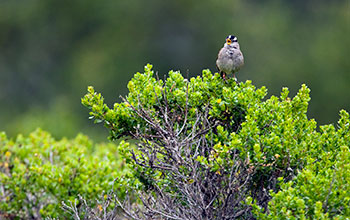Multimedia Gallery
White-crowned sparrow singing
A white-crowned sparrow singing.
More about this image
In science, researchers study model organisms to better understand biological processes. All model organisms share a few common traits: They're inexpensive, easy to care for, grow quickly and are relatively simple creatures.
"Model organisms are vital for biological research," says Robert Miller, a deputy division director in the National Science Foundation's (NSF) Biological Sciences Directorate. "They allow us to explore fundamental biological processes--the rules of life universal to all organisms. We can then apply this knowledge to more and more complex species, such as humans."
Examples of model organisms include Drosophila (fruit fly), Arabidopsis (mustard plant), zebra fish and Saccharomyces cerevisiae (a particular strain of yeast). But some researchers are looking for additional creatures to help them explore new sets of biological challenges, from how our earliest ancestors first walked on land to the chemistry of our nervous system.
David Luther, a biologist at George Mason University, is studying a more modern phenomenon: how animals adapt to urban environments. With support from NSF (grant IOS 1354756), Luther is using white-crowned sparrows to explore how cities, particularly the human-generated noise within, change how birds communicate.
"We want to know how and why animals are changing the way they communicate acoustically," Luther says. "Are they learning their songs? Is it a fixed sort of thing or is it a more plastic behavior?"
White-crowned sparrows are ideal for research on animal communication because different subspecies produce distinctly different songs. Working in collaboration with Elizabeth Derryberry of Tulane University, Luther compared white-crowned sparrow song recordings from the 1960s to songs from today and found the birds have changed the pitch of their song, probably so they can be heard over rush hour traffic. The birds also sing louder, in the same way you would raise your voice when walking by an active construction site.
The researchers still don't know the exact consequences of this adaptation and how it affects the signals embedded in bird song but they have found that male birds singing at louder sites adjust their pitch accordingly, generating songs with lower vocal performance. This behavior makes them less successful at finding mates.
The study could have implications for how other species exist in urban settings. "Most animals, whether it's a bird or something else, when they're presented with a lot of loud noise they just leave," Luther says. "But there are some animals that persist. If we find out how and why they're able to persist, we could apply this to other species as well."
To learn more, see the NSF Discovery story Earth's weird and wonderful animal models. (Date image taken: unknown; date originally posted to NSF Multimedia Gallery: Dec. 16, 2016)
Credit: Sebastian Kennerknecht
See other images like this on your iPhone or iPad download NSF Science Zone on the Apple App Store.
Images and other media in the National Science Foundation Multimedia Gallery are available for use in print and electronic material by NSF employees, members of the media, university staff, teachers and the general public. All media in the gallery are intended for personal, educational and nonprofit/non-commercial use only.
Images credited to the National Science Foundation, a federal agency, are in the public domain. The images were created by employees of the United States Government as part of their official duties or prepared by contractors as "works for hire" for NSF. You may freely use NSF-credited images and, at your discretion, credit NSF with a "Courtesy: National Science Foundation" notation.
Additional information about general usage can be found in Conditions.
Also Available:
Download the high-resolution JPG version of the image. (3.7 MB)
Use your mouse to right-click (Mac users may need to Ctrl-click) the link above and choose the option that will save the file or target to your computer.

